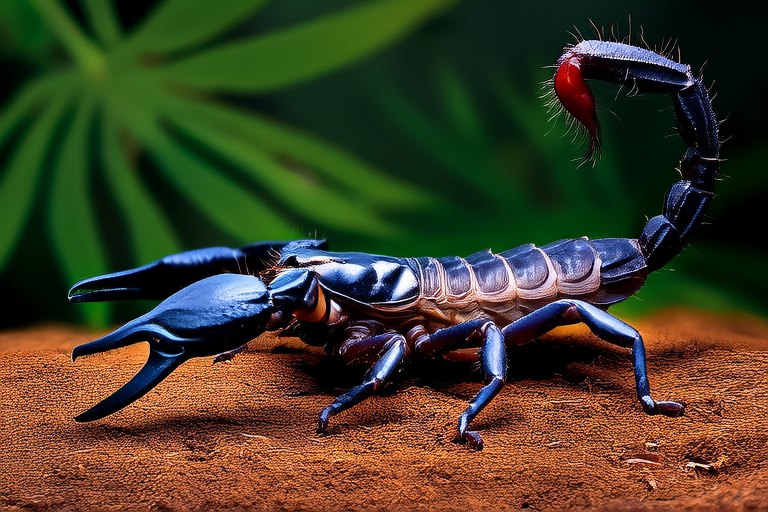Heterometrus Spinifer: Unraveling the Myths Behind This Unique Arachnid
The world of arachnids is vast and diverse, encompassing spiders, scorpions, mites, and more. Among these fascinating creatures, the Heterometrus spinifer, also known as the Asian forest scorpion, stands out due to its unique characteristics and intriguing myths. Often misunderstood and feared, this species plays a crucial role in its ecosystem, contributing to the balance of nature. This article aims to shed light on the truth behind the myths, providing an educational yet captivating insight into the life of the Heterometrus spinifer.
Introduction to Heterometrus Spinifer
The Heterometrus spinifer is a medium-sized scorpion native to Southeast Asia. It belongs to the family Scorpionidae and is easily recognizable by its distinctively long tail and prominent spines. This species typically measures between 7 to 9 centimeters in length, making it one of the larger scorpions found in the region. Its body is segmented, with eight legs and a pair of large pincers at the front. The most striking feature of the Heterometrus spinifer is its tail, which is equipped with a venomous stinger used primarily for defense. Despite its intimidating appearance, this scorpion is generally not aggressive towards humans and prefers to avoid confrontation.
Myths Surrounding Heterometrus Spinifer
One of the most common myths about the Heterometrus spinifer is that it is highly dangerous to humans. While it is true that this scorpion possesses venom, its potency is often exaggerated. In reality, the venom of the Heterometrus spinifer is relatively mild and rarely causes severe harm to humans. Most encounters result in localized pain and swelling, similar to a bee sting. Another misconception is that these scorpions are solitary and territorial. In fact, they are known to live in groups, especially during the mating season, and can be quite social within their colonies.
There is also a widespread belief that Heterometrus spinifers are primarily nocturnal predators, hunting large prey such as birds or mammals. However, scientific studies have shown that their diet consists mainly of small insects, earthworms, and other invertebrates. Their hunting technique involves ambushing prey rather than actively pursuing it, relying on their keen sense of touch and vibration detection to locate food sources.
Physical Characteristics and Lifecycle
The physical characteristics of the Heterometrus spinifer are well-suited for its environment. Its dark brown exoskeleton provides excellent camouflage against the forest floor, helping it blend seamlessly with the surroundings. The spines along its tail are not just for show; they play a critical role in defense by deterring potential threats. When threatened, the scorpion will raise its tail and point the stinger at the perceived danger, ready to strike if necessary.
The lifecycle of the Heterometrus spinifer begins with mating, which occurs during the rainy season when temperatures are cooler and humidity is higher. After successful copulation, the female carries the developing embryos internally for several months before giving birth to live young. Typically, a litter consists of around 20 to 30 offspring. These newborn scorpions are born alive and ride on their mother’s back until they molt for the first time, after which they disperse to find their own territories.
Diet and Habitat
The diet of the Heterometrus spinifer is largely composed of small insects and other invertebrates. They are opportunistic feeders, taking advantage of whatever prey is available in their habitat. Their primary hunting ground is the forest floor, where they use their powerful pincers to capture and crush their meals. The scorpions’ ability to adapt to different environments makes them versatile predators, capable of thriving in various ecological niches.
In terms of habitat, the Heterometrus spinifer is most commonly found in tropical rainforests and bamboo thickets throughout Southeast Asia. They prefer humid conditions and areas with plenty of cover, such as under rocks, logs, or within dense vegetation. These habitats provide ample opportunities for hiding from predators and seeking out prey. Additionally, the presence of water bodies nearby is essential for maintaining the high humidity levels that the scorpions require.
Role in Ecosystems and Cultural Significance
The Heterometrus spinifer plays a vital role in maintaining the balance of its ecosystem. As predators, they help control populations of harmful insects and pests, preventing overpopulation and ensuring a healthy distribution of resources. Their presence also serves as an indicator of environmental health; declines in scorpion populations could signal broader ecological issues.
Culturally, the Heterometrus spinifer holds significant meaning in many Southeast Asian societies. In some communities, the scorpion is revered as a symbol of strength and resilience, reflecting its ability to survive in challenging conditions. Traditional beliefs often attribute mystical powers to the creature, with tales of scorpions being guardians of sacred sites or bringers of good fortune. These cultural associations highlight the deep connection between humans and nature, underscoring the importance of preserving biodiversity.
Conclusion: Understanding Heterometrus Spinifer and Conservation Efforts
Understanding the true nature of the Heterometrus spinifer can contribute significantly to broader arachnid conservation efforts. By dispelling myths and promoting accurate information, we can foster greater appreciation for these remarkable creatures and encourage more responsible stewardship of our natural world. Recognizing the value of the Heterometrus spinifer in its ecosystem and culture can inspire renewed commitment to protecting habitats and ensuring the survival of this unique species.
As research continues to uncover new details about the biology and behavior of the Heterometrus spinifer, there is hope that future generations will benefit from increased knowledge and respect for all forms of life. Let us embrace the opportunity to learn from and celebrate the wonders of the natural world, including the fascinating Heterometrus spinifer.
